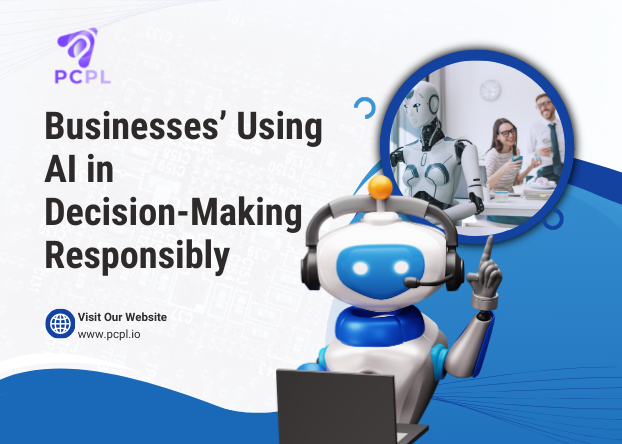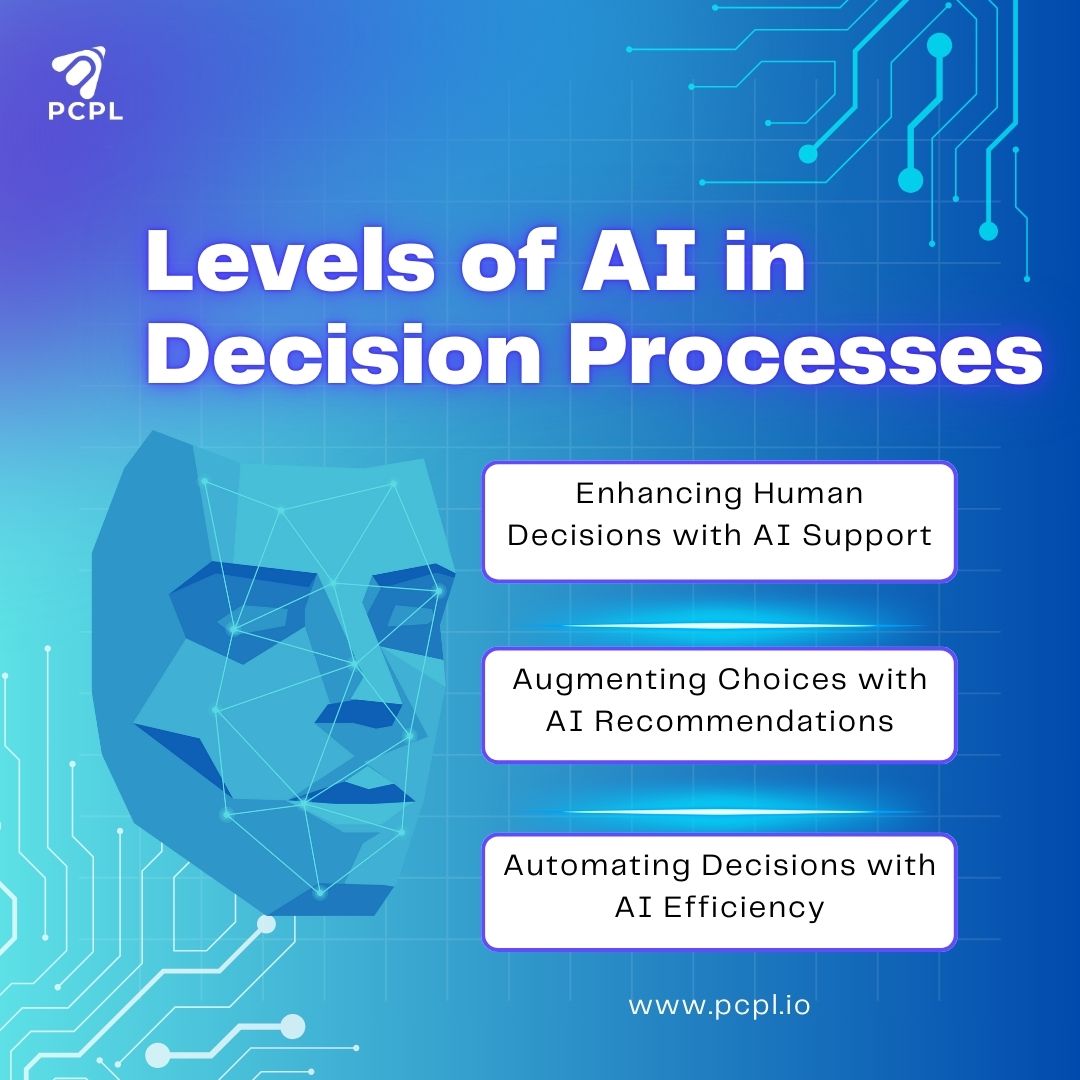
Businesses’ Using AI in Decision-Making Responsibly
The future of business intelligence is being shaped by AI-driven decision-making. For decades, data has been important to businesses, guiding strategic choices and deepening customer understanding.
The explosion of data has created a processing challenge for human analysts. Artificial intelligence offers a powerful solution, automating decision-making processes and empowering businesses to act swiftly, accurately, and consistently based on comprehensive data analysis. AI frees up human capital to focus on strategic initiatives by handling the complexities of large datasets without error.
Business leaders increasingly rely on AI technologies such as machine learning, natural language processing, and computer vision as important tools for boosting profitability and reaching strategic goals. The key to effective business decisions lies in strategically combining human expertise with the power of AI and big data insights.
Artificial Intelligence
Artificial Intelligence (AI) describes a machine’s capacity to mimic human learning and cognitive abilities. The goal of AI is to enable swift problem-solving and decision-making with minimal error. These intelligent machines are often referred to as intelligent bots in the tech world.
The Expanding Landscape
Driven by technological progress, the field of AI has evolved significantly. Currently, AI capabilities are generally categorized into three distinct levels.as follows-
- Assisted Intelligence– This level focuses on automating fundamental tasks, such as machines operating on assembly lines.
- Augmented Intelligence– This represents a collaborative approach where machines learn from human input, and in turn, humans use intelligent information to enhance their decision-making accuracy.
- Autonomous Intelligence– This involves machines fully automating processes without human intervention, exemplified by autonomous robots and self-driving vehicles.
What is AI-Powered Decision-Making?
A key inquiry revolves around the nature of decision-making within artificial intelligence. AI’s role in business decision-making is essential when an AI platform manages data processing, whether entirely or in part. This autonomous or semi-autonomous process excels at quantifying data, enabling businesses to make accurate forecasts and precise choices.
AI has significant advantages in areas such as identifying anomalies, processing vast amounts of data, performing intricate analyses, optimizing decision outcomes, and uncovering hidden trends. The final decisions are then either executed automatically or finalized by human oversight.
Exploring the Levels of AI in Decision Processes

- Enhancing Human Decisions with AI Support– Through predictive, diagnostic, and descriptive analytics, AI provides the insights humans need to make more accurate decisions. The value lies in the powerful combination of human intelligence and data-driven analysis. Integrating practical wisdom and expertise with AI’s capabilities can maximize its impact in business.
- Augmenting Choices with AI Recommendations– Utilizing predictive and prescriptive analytics, AI suggests a range of potential decision options. The collaboration between AI’s processing power and human understanding allows for swift analysis of large datasets, reducing complexity.
- Automating Decisions with AI Efficiency– Similar to augmentation, automation relies on predictive and prescriptive analytics. Businesses gain from AI’s ability to make decisions with greater scalability, speed, and consistency.
Determining the Right Time for AI in Decision-Making
The optimal level of AI integration in decision-making, whether through full automation, human augmentation, or AI-powered support depends on two key factors- the urgency of the decision and its complexity.
The Time Dimension
The time dimension refers to the window between identifying an opportunity or threat and taking action. This timeframe varies significantly depending on the task. For example, high-frequency stock trading demands decisions in mere microseconds, while payroll decisions might allow for several weeks. Strategic mergers or acquisitions could even involve decision-making processes spanning months or years.
The Complexity Spectrum
Drawing from the Cynefin framework, the complexity of a situation exists on a continuum
- Simple– Characterized by predictability and clear cause-and-effect relationships, such as routine payroll processing.
- Complicated– Requiring specialized knowledge and analysis to understand the relationship between cause and effect, as seen in marketing campaigns or asset management.
- Complex– Involving numerous interconnected elements and dependencies, necessitating a holistic and systemic approach. Simulations are often crucial for understanding the broader impact of business intelligence decisions, such as in supply chain distribution.
- Chaotic– Defined by unclear cause-and-effect dynamics and volatile interdependencies, where even minor changes can have unpredictable consequences, like natural disasters or stock market crashes. Effective decision-making in such scenarios relies heavily on practical learning and experimentation.
The Transformative Power of AI in Decision Making
Artificial intelligence is becoming central to business operations due to its inherent ability to learn and adapt. Enhanced data-driven decisions directly correlate with improved learning outcomes. AI can autonomously train itself using vast datasets to construct sophisticated language models. These models have the capability to make accurate decisions and categorize new information effectively. Similarly, Large Language Model (LLM) software solutions analyze data in real time, generating predictions, categorizations, and recommendations that ultimately lead to more informed business choices.
Consider established companies like Amazon, which use customer transaction data to gain valuable insights. This approach allows them to identify customer segments that frequently purchase specific products together. Consequently, their systems can recommend related items on their websites, enhancing the customer experience and driving sales.
Traditionally, human analysis has been the cornerstone of decision-making. Professionals would analyze data to determine target customer groups or estimate the costs associated with product launches. Moreover, marketing campaigns carried significant uncertainty in this environment.
AI Adoption For Decision-Making
The adoption of AI has surged in recent years, according to a McKinsey survey. Since 2019, the number of firms embracing AI has more than doubled. While the overall proportion of companies utilizing AI has stabilized between 50 and 60 percent, a distinct group of AI-proficient organizations are achieving superior financial results, gaining a significant competitive edge.

This increased adoption sees a doubling of the average number of AI capabilities deployed, rising from 1.9 in 2018 to 3.8 in 2023.
Robotic process automation and computer vision remain leading applications, with natural-language text understanding rapidly gaining prominence. These trends show the growing reliance on AI systems for complex problem analysis.
Top Applications Shaping Decisions
The primary use cases for AI in decision-making have shown remarkable consistency. Optimizing service operations consistently ranks highest, followed by the development of new AI-powered products, customer service analytics, customer segmentation, and customer acquisition. These applications demonstrate AI’s versatility in enhancing operational efficiency and enriching customer interactions.
Growing Investment Signals Confidence
The adoption of AI shows a rise in investment. Previously, only 40 percent of AI-using organizations allocated over 5 percent of their digital budgets to AI. Now, more than half report this level of commitment. Looking ahead, 63 percent of the respondents believe there will be further increases in AI investment over the next three years.
Evolving Areas of Value Creation
The business functions realizing the greatest revenue gains from AI have shifted. While manufacturing and risk were initially prominent, marketing and sales, product and service development, and strategy and corporate finance now report the most significant revenue effects. Notably, supply chain management has emerged as the area yielding the highest cost savings through AI implementation.
Dealing With the Risks of AI Integration
Despite the significant advancements in AI adoption and investment, progress in mitigating AI-related risks has stagnated since 2020. Addressing the ethical and practical challenges associated with AI implementation remains crucial for organizations to fully and responsibly use its potential for decision-making.
Embracing AI for a Competitive Future
AI is playing an increasingly vital role in business decision-making, driving operational improvements and boosting financial performance for many organizations. The growing investment and expanding areas of value underscore AI’s transformative power. However, a continued focus on managing AI-related risks is essential to ensure its sustainable and ethical application.
The Transformative Benefits of AI in Decision-Making
Artificial intelligence is important for the future, serving as the foundation of computer learning. AI empowers computers to use vast quantities of data, enabling them to make optimal decisions with remarkable speed, far surpassing human capabilities. Today, AI is driving progress across numerous fields, from groundbreaking cancer research to innovative solutions for climate change.

- Empowering Business Decisions– AI facilitates rapid analysis of extensive datasets, enabling businesses to make swift and informed decisions.
- Supercharging Sales and Marketing– AI-powered decision-making tools, such as Natural Language Processing, provide businesses with deep insights into customer interactions, revealing the language and tones that resonate most effectively.
- Deepening Customer Understanding– AI tools, including machine learning algorithms and chatbots, offer enhanced comprehension of customer satisfaction levels and evolving expectations.
- Dealing with Complex Data Landscapes– AI excels at extracting meaningful insights from large and intricate datasets, particularly when desired outcomes are clearly defined and measurable.
Real-World Examples
- Smarter Weather Forecasting– AI has become crucial in bridging the gap between climate science and actionable data, leading to more accurate predictions. This helps businesses across industries prepare for and mitigate weather-related risks.
- Disaster Preparedness– AI-powered decision-making algorithms are equipping companies to better anticipate and respond to disasters, minimizing potential damage and improving recovery efforts.
- Economic Growth Catalyst– Research suggests that AI has the potential to significantly boost global GDP, acting as a “capital hybrid” that enhances both economic and human productivity.
AI in Marketing Decisions
Marketing decisions are often complex, especially with increasingly intricate customer-driven market dynamics. Understanding evolving customer needs and aligning products accordingly is paramount. AI offers valuable tools for navigating this complexity
- Gaining Customer Insights- AI modeling and simulation techniques help businesses gain deeper insights into buyer behavior, both in the short and long term.
- Predicting Customer Behavior- AI-powered decision support systems can better predict customer actions, enabling more effective marketing strategies. These systems facilitate real-time data gathering, forecasting, and analysis of market trends.
Enhancing Customer Relationships with AI
AI has significantly improved customer relationship management (CRM) by automating key functions such as data recording, contact management, data analysis, and lead ranking. Further, AI-driven buyer persona models can even predict a customer’s lifetime value, empowering marketing teams to operate more efficiently and effectively.
Driving Engagement with AI
Initially popularized by music streaming platforms, AI-powered recommendation systems have expanded across numerous industries. These systems learn individual user preferences and then suggest relevant content, effectively reducing bounce rates and enabling more targeted content delivery.
Boosting Efficiency Through AI-Driven Automation
AI’s impact on automation extends far beyond traditional assembly lines. It’s now enhancing efficiency in business functions like marketing and distribution, providing decision-makers with reliable insights and accelerating processes.
- Smarter Marketing Automation– AI provides valuable customer insights that enhance interactions. Automated market segmentation and campaign management contribute to more effective decision-making.
- Optimized Distribution– AI-powered distribution automation is a key feature for many retailers. It enables them to monitor and control the market, predict demand, and give responses to product needs more accurately.
The Future of Intelligent Decisions
AI’s ability to analyze vast datasets is spearheading a revolution in business intelligence, significantly improving how decisions are made. Machine learning, natural language processing, and computer vision stand as critical AI tools that empower organizations to make quicker and more precise choices.
Offering a range of assistance from task automation to full autonomy, AI adapts to diverse operational needs. Businesses are increasingly capitalizing on these capabilities in areas like marketing, sales, product development, and strategy to optimize operations and generate greater profitability.
Looking ahead, addressing the challenges associated with AI adoption will be essential for businesses seeking to unlock its full transformative power.
References
https://www.multimodal.dev/post/ethical-ai-companies
https://www.ibm.com/think/insights/ai-decision-making-where-do-businesses-draw-the-line
https://indatalabs.com/blog/artificial-intelligence-decision-making
